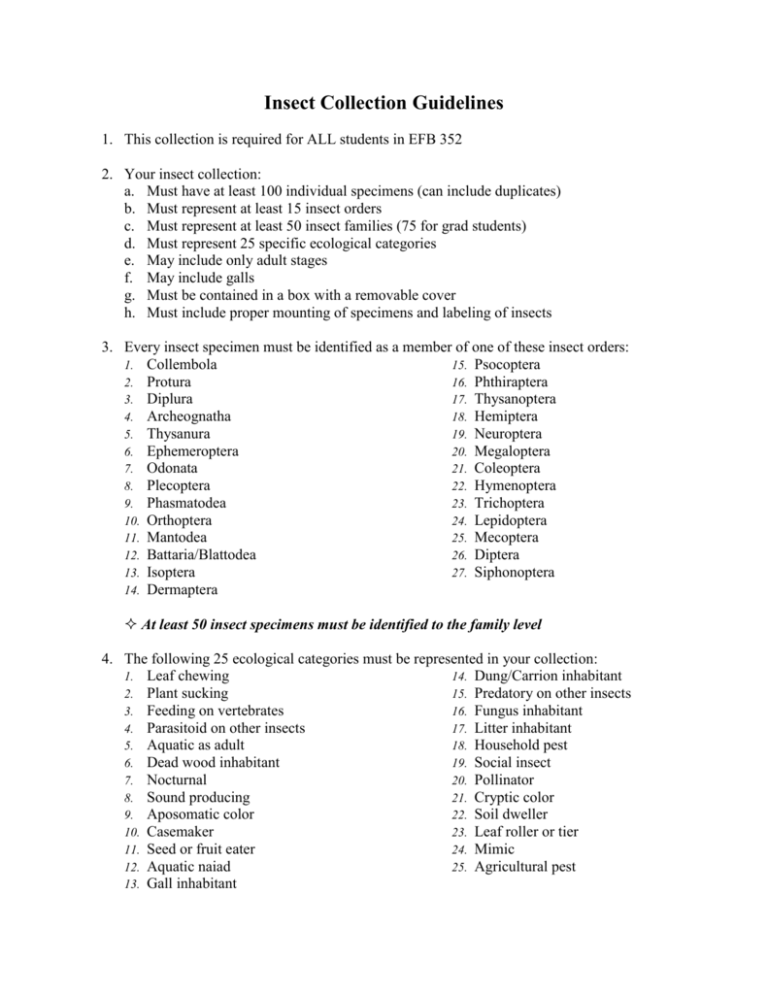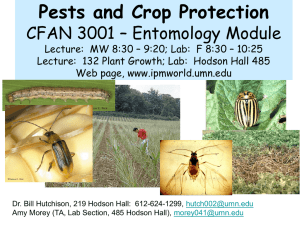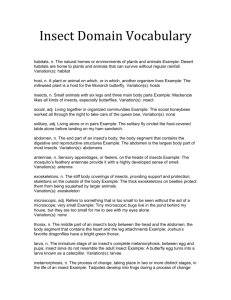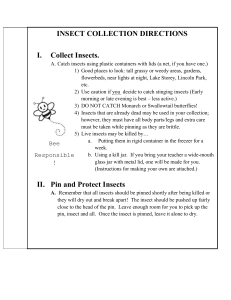Insect Collection Guidelines
advertisement

Insect Collection Guidelines 1. This collection is required for ALL students in EFB 352 2. Your insect collection: a. Must have at least 100 individual specimens (can include duplicates) b. Must represent at least 15 insect orders c. Must represent at least 50 insect families (75 for grad students) d. Must represent 25 specific ecological categories e. May include only adult stages f. May include galls g. Must be contained in a box with a removable cover h. Must include proper mounting of specimens and labeling of insects 3. Every insect specimen must be identified as a member of one of these insect orders: 1. Collembola 15. Psocoptera 2. Protura 16. Phthiraptera 3. Diplura 17. Thysanoptera 4. Archeognatha 18. Hemiptera 5. Thysanura 19. Neuroptera 6. Ephemeroptera 20. Megaloptera 7. Odonata 21. Coleoptera 8. Plecoptera 22. Hymenoptera 9. Phasmatodea 23. Trichoptera 10. Orthoptera 24. Lepidoptera 11. Mantodea 25. Mecoptera 12. Battaria/Blattodea 26. Diptera 13. Isoptera 27. Siphonoptera 14. Dermaptera At least 50 insect specimens must be identified to the family level 4. The following 25 ecological categories must be represented in your collection: 1. Leaf chewing 14. Dung/Carrion inhabitant 2. Plant sucking 15. Predatory on other insects 3. Feeding on vertebrates 16. Fungus inhabitant 4. Parasitoid on other insects 17. Litter inhabitant 5. Aquatic as adult 18. Household pest 6. Dead wood inhabitant 19. Social insect 7. Nocturnal 20. Pollinator 8. Sound producing 21. Cryptic color 9. Aposomatic color 22. Soil dweller 10. Casemaker 23. Leaf roller or tier 11. Seed or fruit eater 24. Mimic 12. Aquatic naiad 25. Agricultural pest 13. Gall inhabitant 5. The collection box has no rules or guidelines other than having a removable lid. Boxes in last year’s collections ranged from pizza boxes to a professional museum-quality drawer. Most land somewhere in between, the choice is yours. I’ll give you suggestions the first week of lab. 6. Although it is not required to spend a lot of money on equipment for this collection, the more equipment you have, the easier it will be for you. Most things can be purchased, or made at a lower cost. Items may be obtained from one of these supply houses, if so desired: Wards Scientific P.O. Box 92912 Rochester, NY 14692 (800) 962-2660 http://www.wardsci.com/ BioQuip Products (my personal recommendation) 17803 La Salle Ave. Gardena, CA 90248 (310) 324-0620 http://www.bioqiup.com/ Carolina Biological Supply 2700 York Rd. Burlington, NC 27215 (800) 334-5551 http://www.carolina.com/ 7. A limited number of nets will be available for use in the lab, but it is suggested that you have your own. A net can either be purchased or made (broom stick, coat hanger, curtain, and duct tape). There are directions on how to make a net on page six in the field guide we will be using for the class (Peterson Field Guide to Insects - America North of Mexico by Donald J. Borer and Richard E. White). 8. You will need a killing jar or other container with a tightly fitting lid in which to place your insects once you have captured them. The container should have a wide mouth so that a variety of sizes of insects can pass through without being damaged. Place cotton balls or another type of absorbent material in the bottom of the jar (plaster of paris works fine). A proper killing agent should be used, for example nail polish remover (acetone) or ethyl acetate. The fumes from this material will ensure a quick kill of the insect and prevent it from being damaged. Be especially careful with butterflies and moths. Make sure there is no free liquid in the jar, as their wings become discolored and stain from contact with it. The fumigant will need to be replenished according to the frequency of container opening. There will be no kill jars available in lab so you must provide your own. If you are collecting over the summer and you don't have a kill jar, then placing them in a freezer will suffice. 9. It is very important to keep an exact record of the location and date of when your insects were collected. A specimen without this information is worthless. Be sure to keep track of the following information about your insects: a. Place collected km east Jamesville b. Where was the insect found? 5Onondaga Co., NY: USA On Acer saccharum Family Saturnidae (what type of plant, in a 6 June, 2005 J. Smith burrow, under the litter, … etc.) c. Date collected d. Name of collector e. Also take a few moments to observe the behavior of the insect. How does it fly? Is it eating? What is it eating? Is it interacting with other insects? With member of the same species or different species? This information may be helpful in the later identification of the insect. Every specimen in your collection is required to have a data label. Usually, a separate, label is made with identification info (family). The labels are stored below the insect on the insect pin. They are spaced so you can easily read both labels. 10. Insects can be stored in a tightly sealed plastic bag in your freezer until you are prepared to pin them in the fall. Soft-bodied insects (aphids, mayflies, stoneflies, and others) should be preserved in 70-80% ethanol in vials. EtOH can be bought at most drug stores (don't use isopropyl). Each vial should contain representatives of one species only, collected at one place at one time. Collection information should be placed inside the vials and written in alcohol proof ink or pencil. Feel free to start pinning your insects over the summer, or you can wait until class starts. Most insect ID books give some tips on pinning the various orders. Insect pins are available at the bookstore (Follet's) or one of the companies mentioned earlier. Butterflies and moths start becoming brittle after about one and a half months in the freezer so you may want to consider pinning them. They are the most difficult to pin and require a spreading board. You can make a cheap spreading board by hollowing out a groove in a flat piece of styrofoam. 11. You may use your field guide as a method of identification, but since it is a field guide, some insects will not be found in it. Other material will be provided in lab to help you with the harder to identify insects. More specific field guides are available, for example Peterson's Guide to Beetles or Peterson's Guide to Butterflies, etc. I recommend that you avoid the Audubon Field Guide to Insects and Spiders 12. First week of lab: Please bring in your killing jar. I will have some plaster of paris available to make a kill jar to use for the semester. Also bring insect pins. We will be collecting insects in Oakwood Cemetery and we will practice pinning techniques in the lab.








